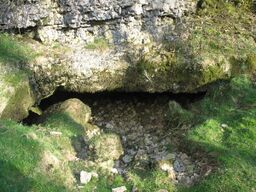Earth:Pate Hole
| Pate Hole | |
|---|---|
 The entrance to Pate Hole | |
| Lua error in Module:Location_map at line 522: Unable to find the specified location map definition: "Module:Location map/data/Cumbria" does not exist. | |
| Location | Great Asby, Cumbria, England |
| OS grid | NY 678 121 |
| Coordinates | [ ⚑ ] : 54°30′13″N 2°29′53″W / 54.5035°N 2.4981°W[1] |
| Depth | 33 metres (108 ft)[1] |
| Length | 970 metres (3,180 ft)[1] |
| Elevation | 195 metres (640 ft)[1] |
| Geology | Carboniferous limestone |
| Entrances | 1 |
| Difficulty | III[1] |
| Hazards | flooding[1] |
| Cave survey | On Cavemaps |
Pate Hole is a solutional cave located adjacent to Asby Gill 1 kilometre (0.62 mi) south of Great Asby in Cumbria, England . It is 970 metres (3,180 ft) long and has a vertical range of 33 metres (108 ft). The entrance is normally dry, but in flood it becomes an impressive resurgence.[1] Its name derives from the north country word for badger.[2]
It consists of three main passages. From the entrance a stooping height passage heading south-east reaches a large 6 metres (20 ft) deep pool after 330 metres (1,080 ft) from which a stream emerges. This flows down a low passage to the north for some 270 metres (890 ft) where a sump is reached. The third main passage continues south underwater from the pool for 225 metres (738 ft) at a depth of 27 metres (89 ft) where it reaches a junction and becomes too restricted.[1]
The cave is formed in Carboniferous limestone,[3] and is thought to drain the Great Asby Scar area 3 kilometres (1.9 mi) to the south-west.[4] The resurgence is presumed to be St. Thomas's Well in Great Asby.[5]
The main part of the cave has been known for a long time, and it was an object of curiosity in the nineteenth century.[6] A brief foray into it was described in The Gentleman's Magazine in 1791,[7] and a description appeared in The Monthly Magazine in 1802.[2] The first full description complete with passage lengths appeared in 1813.[8] The first account of an exploration by cavers was in 1941 by members of the Yorkshire Ramblers' Club,[9] and in November 1946 it was surveyed by a group from Appleby Grammar School led by Brian Price.[10] The upstream sump was first dived for about 10 metres (33 ft) to a descending rift in 1960 by members of the Cave Diving Group, at which time the main part of the cave was re-surveyed by Warburton et alia. Further exploration took place in 1975-1976 by members of the same group to reach the current limit.[4]
References
- ↑ Jump up to: 1.0 1.1 1.2 1.3 1.4 1.5 1.6 1.7 Brook, Dave (1994). Northern Caves Volume 3. The Three Counties System and the North West. Skipton: Dalesman Publishing Company Ltd.. pp. 254–255. ISBN 1855680831.
- ↑ Jump up to: 2.0 2.1 Phillips, Richard (1 February 1802). "Account of Asby in the County of Westmoreland". The Monthly Magazine XIII (1): 115–116. https://books.google.com/books?id=DDSx3kVT1RMC&q=pate+hole&pg=PA115. Retrieved 31 March 2017.
- ↑ "Geology of Britain Viewer". British Geological Survey. http://mapapps.bgs.ac.uk/geologyofbritain/home.html. Retrieved 30 December 2013.
- ↑ Jump up to: 4.0 4.1 Metcalfe, Dave (October 1978). "Pate Hole". Belfry Bulletin (366): 4. http://bec-cave.org.uk/publications-mainmenu-32/belfry-bulletin-mainmenu-33/418-belfry-bulletin-no-366-october-1978.html?start=3. Retrieved 30 December 2013.
- ↑ Hill, Elaine; Hall, Adrian (2015). Northern Sump Index 2015. Cave Diving Group. p. 288,343. ISBN 978-0-901031-08-2.
- ↑ Bell, Thomas (1836). The scientific tourist through England, Wales & Scotland, Volume 2. Glasgow: A Fullarton and Co. p. 64.
- ↑ "Letter from T.C.". The Gentleman's Magazine 70: 923. 1791. https://books.google.com/books?id=-3rPAAAAMAAJ&q=%22pate+hole%22&pg=PA923. Retrieved 31 December 2013.
- ↑ Bitton, John (1813). The Beauties of England and Wales. London: Longman & Co.. pp. 152–153. https://books.google.com/books?id=Z6oMAAAAIAAJ&q=%22pate+hole%22+badger&pg=RA2-PA152.
- ↑ "Cave Exploration". Yorkshire Ramblers' Club Journal 7 (24): 77–183. 1947. http://www.yrc.org.uk/yrcweb/index.php/journal/vols6-11/78-vol7-cat/no24/438-v7n24p177. Retrieved 30 December 2013.
- ↑ Price, Brian (1947). "Pate Hole, Westmorland (letter)". The British Caver (16): 87–88.
 |

